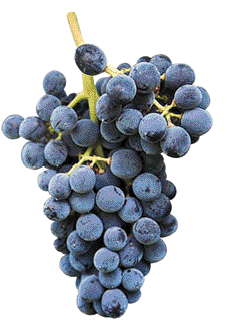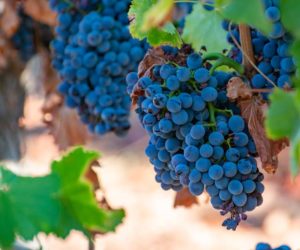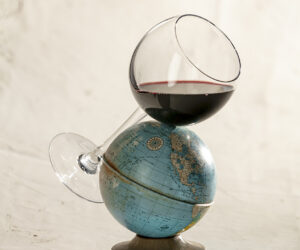 Nero d’Avola, also known as Calebrese, is a lightly tannic, but deeply colored red grape. Its name translates to “Black of Avola,” for the dark color the grapes develop. It is the most popular winegrape in Sicily, and it is becoming increasingly popular in wine drinking circles in North America. Nero needs some additional exposure, however, to really take off as the next big thing in the winemaking world.
Nero d’Avola, also known as Calebrese, is a lightly tannic, but deeply colored red grape. Its name translates to “Black of Avola,” for the dark color the grapes develop. It is the most popular winegrape in Sicily, and it is becoming increasingly popular in wine drinking circles in North America. Nero needs some additional exposure, however, to really take off as the next big thing in the winemaking world.
When most of us think of wines from the central Mediterranean regions of the world we probably often first think of the wines of Tuscany, notably Sangiovese and its association with Super Tuscans, which are blends of Sangiovese, Cabernet Sauvignon and Merlot. To the north there is Barbera and Nebbiolo, and to the south is Aglianico. Those varieties are from the areas that are known as the “knee” and the “boot” of Italy. However, there are many locally popular and surprising wines coming from the “football” of Italy, that is, the islands situated in the Mediterranean. This is especially true from Sicily, which was formed by Europe’s only active volcano, Mount Aetna, one of the most active volcanoes on earth.
Sicily’s wine history dates back to ancient Greece, almost 4,000 years ago, when the tiny island was a Hellenic colony. I wish I had paid a little more attention to all the humanities classes I took back in school that discussed the dawn of civilization, but at the time I was more focused on my personal career goals, which didn’t include humanities. Had I paid attention to the humanities “thing,” I would have learned that wine was integral to the dawn, or re-emergence, of civilization.
Archeology has proven that the Greeks made and transported wine around the Mediterranean in traditional vessels called amphorae. Amphorae are somewhat odd shaped ceramic vessels with narrow necks, two handles and a body that varies in size but is always goblet-like. Amphorae were stacked easily in the holds of ships and sealed very well, often preserving their contents for discovery many centuries later. It was the discovery of tartrate crystals on the inside of these ancient amphorae that led archeologists to deduce that the Greeks engaged in a significant amount of wine transport.
The recorded history of Nero d’Avola dates back several hundred years when growers near the town of Avola selected it, but it is unclear if the grape’s history dates back to the ancient Greeks. Many references to the variety indicate it is indigenous to Sicily, so it is safe to assume that this variety has a long history on the island, and it could also perhaps be associated with the Greek colonization of the island.
Today, Sicily is Italy’s largest wine-growing region, accounting for 17.6% of the nation’s vineyards. Italy is all about wine, and Sicily’s legacy of red wine is all about Nero d’Avola, second only to Catarratto Bianco. There are almost 18,000 hectares (about 46,000 acres) of Nero in Sicily. By comparison, in California, there are 100,000 acres of Chardonnay.
The general climate of Sicily is classified as Mediterranean, which is characterized by cool wet winters and hot dry summers. What makes Sicily so unique, however, is that the island has a variety of microclimates. Mount Aetna reaches to more than 10,000 feet and its lower slopes offer rich volcanic soil that is not just home to grapes, but other agricultural crops as well. As you travel upslope, cooler nighttime temperatures prevail, allowing the grapes to hang long and develop ripe mature flavors.
The town of Avola is on the southeast coast of the island, where warm temperatures favor red winegrapes. In addition to Nero, varieties like Frappato, Nerello Mascalese and Nerello Cappuccio are grown in the eastern half of the island in the notable red appellations of Faro DOC, Etna DOC, Cerasuolo Vittoria DOCG, and Eloro Pachino DOC. The traditional whites, Insolia, Grillo and Catarratto Bianco are grown in the west, in the Alcamo DOC. In recent years, however, because of the increasing popularity of Nero D’Avola, plantings have started to spread to the west side of the island.
Outside of Sicily, Nero d’Avola is not extensively grown. There are scant plantings in California; in Mendocino and Napa Counties on the north coast, with the majority of plantings in the hotter, dryer San Joaquin Valley. California only crushed 152 tons of Nero in 2010; down from 259 tons crush in 2009, according to the 2010 California grape crush report. The smaller crop in 2010 sold for a whopping average of $685 per ton, compared to $290 per ton in 2009. Presumably the shorter supply led to higher prices. Elsewhere, Nero was not commercially produced in Australia until 2009. But although it is a definite newcomer in the Australian wine portfolio, vignerons there see its value as a varietal and as a blending grape. Some limited production also occurs in New Zealand.
Nero d’Avola can be made in to a broad range of wine styles; from light, sweet or dry rosatos to serious reds that can be likened to Australian Shiraz, as well as Port-style wines and Marsala. The typical wine made from Nero d’Avola, however, is a dry red. It can make an excellent single-varietal wine, but is also a solid blender. In fact, wines made from the grape are often used in France to bolster color in vintages of lesser quality — so much so that some French producers nicknamed the wine “Le vin medicine” (the wine medicine). Some of the wines made in Sicily are rich and syrupy, with alcohols approaching 18%. In these instances, the wine is used when making Marsala, a fortified wine made in a style that crosses Madeira and sherry in the Marsala DOC.
There has been a recent push to expose Nero d’Avola wines outside of Sicily, and Italy in general, and consumers are starting to catch on. I attended the annual Tre Bicchieri tasting event in 2011, which is produced by Gambero Rosso, an Italian publishing company devoted to Italian wine and culture. Tre Bicchieri literally translates to “three glasses” and is the Italian rating system to indicate the highest classification of wines that they review. Gambero Rosso holds these tastings annually in major cities throughout the United States, and that year the San Francisco event featured some wines made from Nero d’Avola that were very unique.
To make the dry style of Nero d’Avola, the grapes must be destemmed, crushed and then fermented at an even rate so that off flavors are not produced. The style is light in tannin but deep in color. Descriptors of the finished wine often include strawberry, dark cherry, plum, black pepper, earthiness, mushroom and leather. Aging in good quality French oak can round out the mouthfeel with notes of cream and vanilla. The wines made this way are generally not astringent, so they are drinkable young, and with enough acid structure they can age up to five or even ten years. The grapes can be hard to find, however. Unless you can source grapes locally, your best bet is to find a source of juice on the Internet, or give a Nero wine kit a try. There are an increasing amount of Nero d’Avola wine kits on the market from most kit companies.
Pairing Nero with food is relatively simple. As expected, it is fabulous with spaghetti. After all, why would the Italians produce a wine that didn’t go well with red sauces and spaghetti? Grilled meats are also a guaranteed good pairing thanks to the light tannin structure of the wine. Recently, my wife and I also had it with pizza that was covered with scallops, calamari and shrimp. We were a little surprised at how well the wine was matched with the seafood. We both agreed that it must have been the wine’s acidity that gave it backbone.
If you ask me, Nero d’Avola is a great Sicilian red wine with a lot of potential. Finding much information on the wine — and how to make it — can be difficult, however, and with such few producers in the United States, we must rely more on Italian imports for commercial examples. Visit your local bottle shop and talk with the experts about getting more Nero d’Avola choices. I think you will be impressed — hopefully enough to give the grape a try in your own home winery.
Nero d’Avola Recipe
(yield: 5 gal/19 L)
Ingredients
• 5 gallons (19 L) Nero d’Avola juice
• 5 grams Lalvin D254 or ICV-GRE yeast (you can substitute Premier Cuvée but cut back on the yeast nutrients by half if you do)
• 10% potassium metabisulfite (KMBS) solution: Weigh 10 grams of KMBS, dissolve into about 50 milliliters (mL) of distilled water. When completely dissolved, make up to 100 mL total with distilled water.
• 5 grams Go-Ferm (or equivalent yeast starter)
• 10 grams Fermaid K (or equivalent yeast nutrient)
• 5 grams Di-ammonium Phosphate (DAP)
• Freeze-dried malolactic culture
Other equipment or needs
• 6-gallon (23-L) food-grade plastic bucket for fermentation
• 5-gallon (19-L) carboy
• (1 or 2) 1-gallon (3.8-L) jugs
• Racking hoses
• Inert gas (nitrogen, argon or carbon dioxide)
• Ability to attain and maintain a fermentation temperature of 80 °F (27 °C) during peak fermentation (peak fermentation is defined as starting at 21 °Brix and dropping to 11 °Brix) TIP: Use a 33-gallon (125-L) plastic can as a water bath. If you need to, place ice blocks in the water to maintain a relatively constant temperature if it looks like your temperature may exceed the limit. If you need to keep it warm, wrap the bucket/carboy with an electric carboy wrap (available at most home winemaking outlets).
• Ability to hold wine at 50–55 °F (10–13 °C) while settling.
• Thermometer capable of measuring between 40-110 °F (4-43 °C) in one degree increments.
• Pipettes with the ability to add in increments of 1 milliliter.
• Clinitest® tablets to measure residual sugar at the completion of fermentation.
Step by step
1. Clean and sanitize all your winemaking tools, supplies and equipment.
2. Mix into the juice the Fermaid K or equivalent yeast nutrient.
3. Prepare yeast. Heat about 50 mL distilled water to 108 °F (42 °C). Mix the Go-Ferm into the water to make a suspension. Measure the temperature. Pitch the yeast when the suspension is 104 °F (40 °C). Sprinkle the yeast on the surface and gently mix so that no clumps exist. Let sit for 15 minutes undisturbed. Measure the temperature of the yeast suspension. Measure the temperature of the juice. You do not want to add the yeast to your cool juice if the difference in temperature of the yeast and the must exceeds 15 °F (8 °C). To avoid temperature shock, acclimate your yeast by taking about 10 mL of the juice and adding it to the yeast suspension. Wait 15 minutes and measure the temperature again. Do this until you are within the specified temperature range. Do not let the yeast sit in the original water suspension for longer than 20 minutes. When the yeast is ready, add it to the fermenter.
4. Initiate the fermentation at room temperature (~65-68 °F/18-20 °C) and once fermentation is noticed, (~24-48 hours) move to the water bath described above. You should see signs of fermentation within about one to two days. This will appear as some foaming on the juice.
5. Two days after fermentation starts, dissolve the DAP in as little distilled water required to completely go into solution (usually ~ 20 mL). Add directly to the fermentation.
6. Normally you would monitor the progress of the fermentation by measuring Brix. One of the biggest problems with making wine in small quantities at home is maintaining a clean fermentation. Entering the carboy to measure the sugar is a prime way to infect the fermentation with undesirable microbes. So at this point, the presence of noticeable fermentation is good enough. If your airlock becomes dirty by foaming over, remove it and clean it and replace as quickly and cleanly as possible. Sanitize anything that will come in contact with the juice, you should at least be monitoring temperature. Sanitize your thermometer before use.
7. Leave alone until bubbles in the airlock are about one bubble per minute. Usually about seven to ten days. Then measure the Brix every two to three days.
8. The wine is considered dry, or nearly dry when the Brix reach -1.5 Brix or less. Measure the residual sugar using the Clinitest®. If dry, it should measure about 2 g/L Transfer the wine to the 5-gallon (19-L) carboy and maintain the temperature at around 70–75 °F (21–24 °C).
9. Pour your malolactic culture directly into the wine. Observe the wine for continued fermentation which should last another 2-3 weeks. When this ceases, add 3 mL of fresh KMBS (10%) solution per gallon of wine. This is the equivalent to ~40 ppm addition. After two weeks, test for pH and Free SO2 adjust as necessary to attain 0.8 ppm molecular SO2. (There is a simple SO2 calculator on the Web at www.winemakermag.com/guide/sulfite). Check the SO2 in another two weeks, prior to the next racking and adjust while racking. HINT: Rack to another sanitized 5-gallon (19-L) carboy, or your bucket. In the case of the latter, clean the original carboy and transfer the wine back to it. This is done at about four to six weeks after the first SO2 addition. Once the free SO2 is adjusted, maintain at the target level by monitoring every three to four weeks.
10. Consult winemakermag.com for tips on fining and filtration.
11. At about three months you are ready to bottle the wine. Be sure to maintain sanitary conditions while bottling. Once bottled, you will need to periodically check your work — which is a good opportunity to invite some friends over and open a bottle to enjoy.





